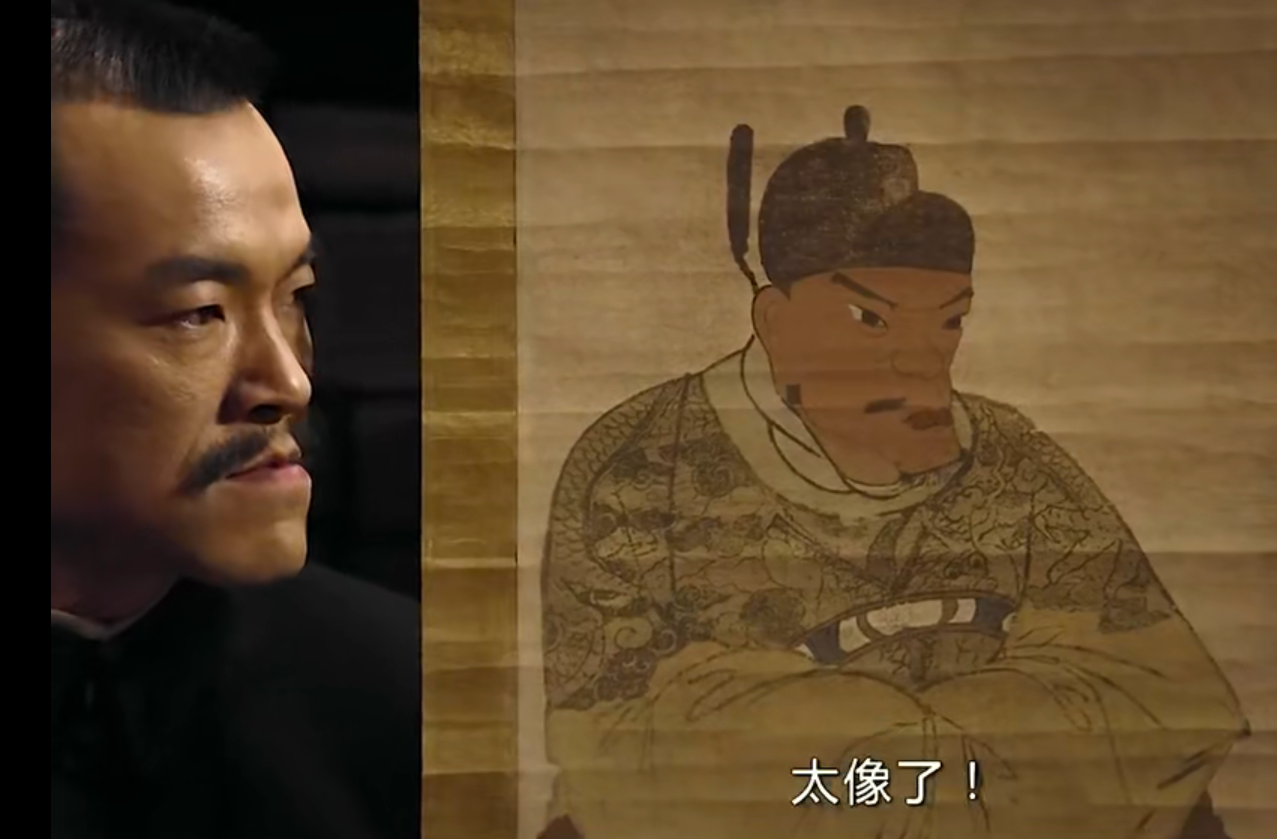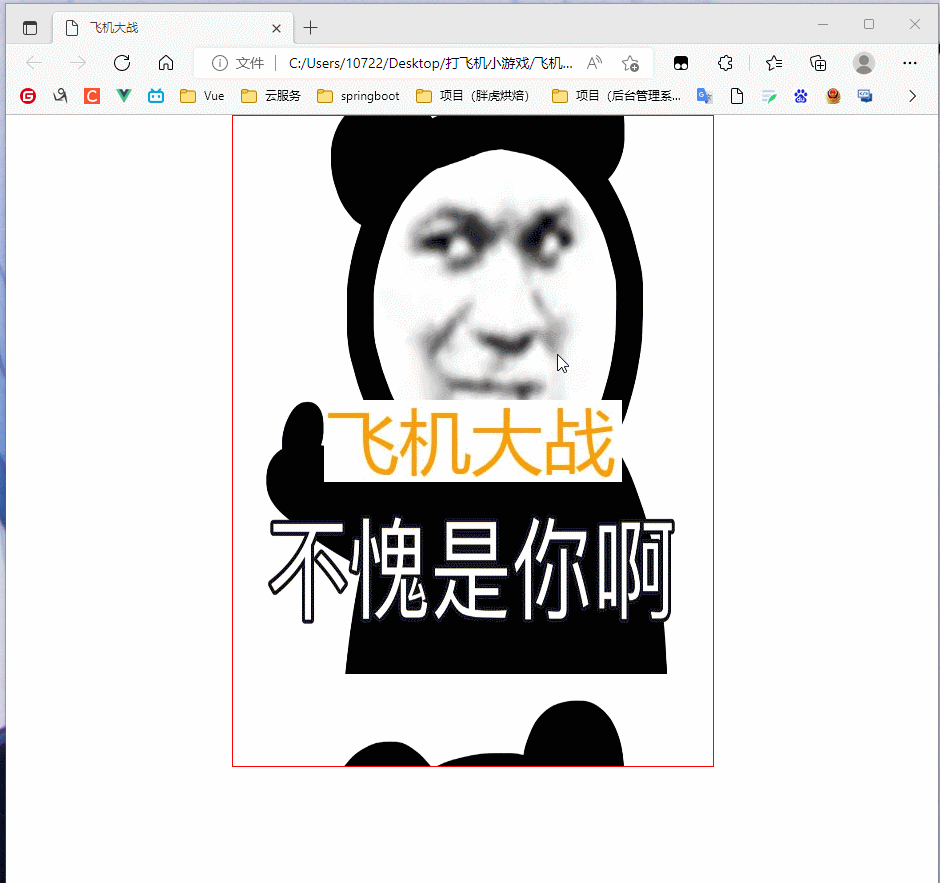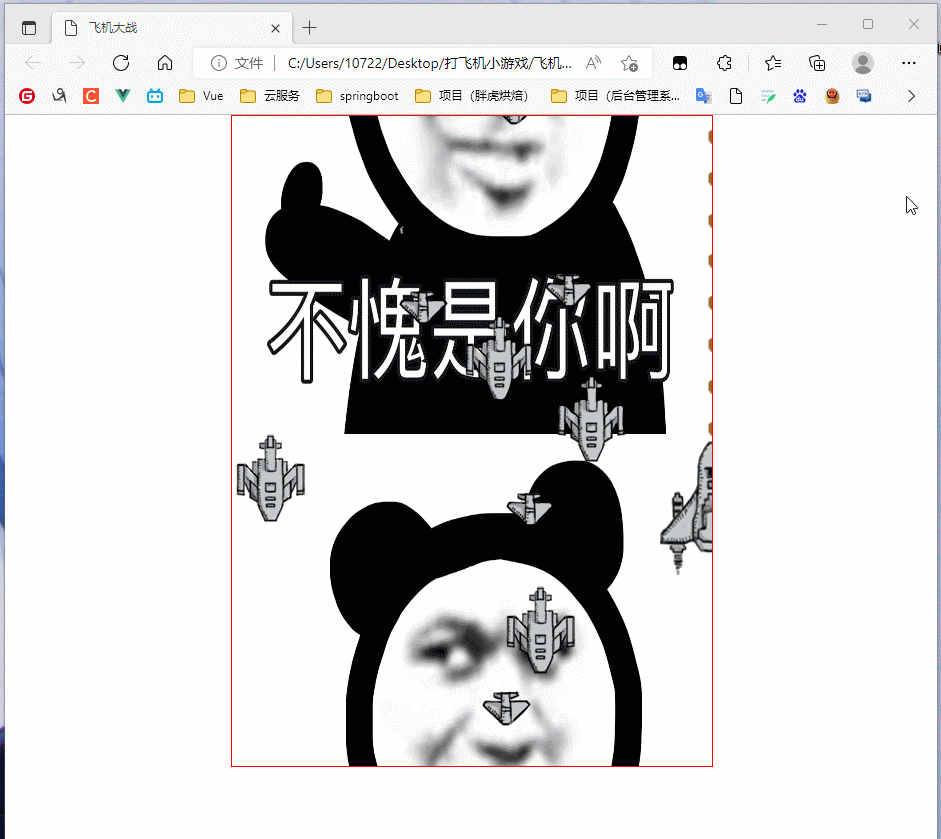好家伙,本篇介绍敌机
好了,按照惯例我们来理一下思路:
我们有一个敌机类,第一步当然是实例一个敌机对象,
然后我们把这个敌机放入我们的敌机群(敌机数组)
然后是熟悉的移动和绘制
那我们回顾一下子弹的生成逻辑
变量: 子弹 bullet 弹夹(用来装子弹的东西)bulletList[]
方法:装填子弹 绘制子弹 移动子弹
子弹发射的物理逻辑是很简单的:
生产第一个子弹,推入弹夹中,绘制弹夹(即绘制弹夹中的所有子弹),
生产第二个子弹,同样推入弹夹,移动第一颗子弹(应该说是改变第一颗子弹的y坐标),绘制弹夹中的所有子弹
。。。。。。
生产第n个子弹,推入弹夹中,改变第n-1颗子弹的Y坐标,绘制弹夹中的所有子弹
有没有感觉到两者逻辑的相似之处
(像啊,太像了)

子弹和敌机的处理,本质上是用的是同一套逻辑
那么,开始干活:
1.配置项
这里我们会用到两种类型的配置项E1和E2
(因为我们有两种类型的敌人,大敌机和小敌机,其中e1为小敌机(血少),e2为大敌机(血厚))
先设置一个数组存放图片资源

//e1用于存放小敌机的图片素材
const e1 = {
live: [],
death: [],
}
e1.live[0] = new Image();
e1.live[0].src = "img/enemy1.jpg"
e1.death[0] = new Image();
e1.death[0].src = "img/enemy1_boom1.jpg"
e1.death[1] = new Image();
e1.death[1].src = "img/enemy1_boom2.jpg"
e1.death[2] = new Image();
e1.death[2].src = "img/enemy1_boom3.jpg"
//e2用于存放小敌机的图片素材
const e2 = {
live: [],
death: [],
}
e2.live[0] = new Image();
e2.live[0].src = "img/enemy2.jpg"
e2.death[0] = new Image();
e2.death[0].src = "img/enemy2_boom1.jpg"

![]()





(图片素材来自网络)
2.敌机配置项

//小敌机
const E1 = {
type: 1,
width: 57,
height: 51,
life: 1, //少点血,一下打死
score: 1,
frame: e1,
minSpeed: 20,
maxSpeed: 10,
}
//大敌机
const E2 = {
type: 2,
width: 69,
height: 95,
life: 2,
frame: e2,
minSpeed: 50,
maxSpeed: 20,
}

minSpeed: 50, maxSpeed: 20, 值得说明一下,这两个玩意是为了弄敌机的随机速度(更刺激一点,但实际上好像没什么感觉) 关于如何弄到一个”随机速度“,接着往下看
3.敌机类

class Enemy {
constructor(config) {
//敌机类型
this.type = config.type;
//敌机宽,高
this.width = config.width;
this.height = config.height;
//敌机的初始化位置
this.x = Math.floor(Math.random() * (480 - config.width));
//这里我们让飞机从头部开始渲染,所以Y轴坐标自然是飞机高度的负值
this.y = -config.height;
//敌机生命
this.life = config.life;
//敌机分数
this.score = config.score;
//敌机图片库
this.frame = config.frame;
//此刻展示的图片
this.img = null;
//活着的证明
this.live = true;
// this.minSpeed = config.minSoeed;
// this.maxSpeed = config.speed;
//随机去生成一个速度
this.speed = Math.floor(Math.random() * (config.minSpeed - config.maxSpeed + 1)) + config.maxSpeed;
//最后渲染的时间
this.lastTime = new Date().getTime();
}
//移动敌机
move() {
const currentTime = new Date().getTime();
//
if (currentTime - this.lastTime >= this.speed) {
// console.log("此处为this.frame"+this.frame.live[0]);
this.img = this.frame.live[0];
this.y++;
//时间修正
this.lastTime = currentTime;
}
}
//渲染敌机方法
paint(context) {
// console.log("此处为this.img"+this.img);
if(this.img !=null){
context.drawImage(this.img, this.x, this.y);
}
}
}

3.1.随机速度
先浅浅的说明一下
随机数方法 Math.random
这玩意会在[0,1)也就是在0到1之间取一个值
然后问题来了,这是一个半开半闭区间,也就是说它会取到0但是不会取到1
this.speed = Math.floor(Math.random() * (config.minSpeed - config.maxSpeed + 1)) + config.maxSpeed;
在这里我们要取的是一个10到20之间的速度由于我们向下取整
Math.floor(Math.random() * (config.minSpeed - config.maxSpeed )) + config.maxSpeed;
必然只能取得10-19之间的数
于是我们在(config.minSpeed - config.maxSpeed )中加一
变成(Math.random() * (config.minSpeed - config.maxSpeed +1))
(聪明的你一定能很快想明白,而愚蠢的我想了很久才想明白)
3.2.敌机的移动方法

move() {
const currentTime = new Date().getTime();
//
if (currentTime - this.lastTime >= this.speed) {
// console.log("此处为this.frame"+this.frame.live[0]);
this.img = this.frame.live[0];
this.y++;
//时间修正
this.lastTime = currentTime;
}
}

移动同样的用时间判定的方式去控制速率
现在和过去的时间差大于速度,更新地址
3.3.渲染方法

paint(context) {
// console.log("此处为this.img"+this.img);
if(this.img !=null){
context.drawImage(this.img, this.x, this.y);
}
}

嗯,非常好理解了,多加的一个if是为了防止出现空img导致报错
4.全局函数(生产敌机)

//以下三项均为全局变量
const enemies = [];
//敌机产生的速率
const ENEMY_CREATE_INTERVAL = 2000;
let ENEMY_LASTTIME = new Date().getTime();
//全局函数 用于生产敌机
function createComponent() {
const currentTime = new Date().getTime();
const forenemyTime = new Date().getTime();
//一手经典判断
if (currentTime - ENEMY_LASTTIME >= ENEMY_CREATE_INTERVAL) {
//当时间满足 实例化一架敌机 放入敌机数组中
// 小飞机 70% 中飞机30%
//用随机数去弄概率
//[0,99]
//Math.random()=>[0,1)*100
//EnemyTypeRandom产生的随机数用于判断产生不同的飞机
let EnemyTypeRandom = Math.floor(Math.random() * 100);
if (EnemyTypeRandom > 70) {
enemies.push(new Enemy(E1));
} else if (EnemyTypeRandom < 30) {
enemies.push(new Enemy(E2));
}
console.log(enemies);
//更新时间
ENEMY_LASTTIME = currentTime;
}
}

这里同样的,我们用随机数去控制出现大/小敌机的概率
(E1,E2分别是大小敌机的配置项)

let EnemyTypeRandom = Math.floor(Math.random() * 100);
if (EnemyTypeRandom > 70) {
//产小敌机
enemies.push(new Enemy(E1));
} else if (EnemyTypeRandom < 30) {
//产大敌机
enemies.push(new Enemy(E2));
}

你细品,这个控制得还是非常巧妙的
5.全局函数渲染
到这里就非常简单了
这里也揭开了前面的谜底
因为敌机生成和子弹生成的逻辑太过相似
所以我们把他们放到同一个全局函数是一个非常明智的选择

//全局函数 来移动所有的子弹/敌人组件
function judgeComponent() {
console.log("judge被触发");
for (let i = 0; i < hero.bulletList.length; i++) {
hero.bulletList[i].move();
}
for(let i=1;i<enemies.length;i++){
enemies[i].move();
}
}
//全局函数 来绘制所有的子弹/敌人组件
function paintComponent() {
for (let i = 0; i < hero.bulletList.length; i++) {
hero.bulletList[i].paint(context);
}
for(let i=1;i<enemies.length;i++){
enemies[i].paint(context);
}
}

6.方法调用

case RUNNING:
sky.judge();
sky.paint(context);
//加载主角
hero.paint(context);
hero.shoot();
createComponent();
//子弹发射
judgeComponent();
paintComponent();
deleteComponent();
// context.drawImage(hero_frame.live[0], 0, 0);
break;

ok,来看看效果吧:


确实是非常地nice啊
本文含有隐藏内容,请 开通VIP 后查看